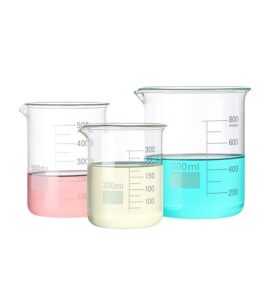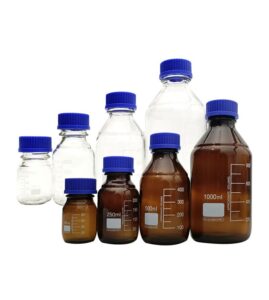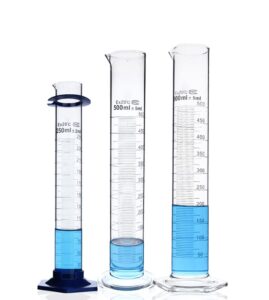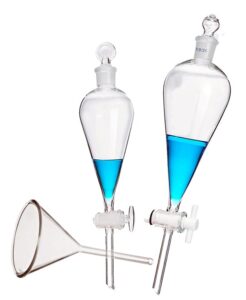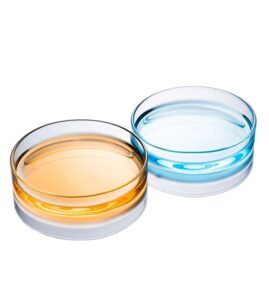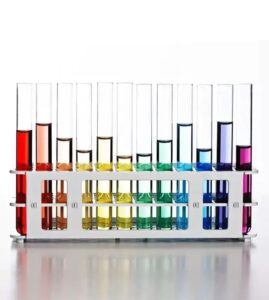Have you ever wondered about the types of glassware used in laboratories? Laboratories rely on a wide range of specialized glassware to conduct experiments, perform measurements, and handle various substances. Each type of glassware serves a specific purpose and is designed to meet the unique requirements of scientific research. In this article, we will explore the different types of glassware commonly found in laboratories and their respective functions.
What Type of Glassware is Used in Laboratories?
Beakers
Beakers are cylindrical containers with a flat bottom and a spout for pouring liquids. They come in various sizes, typically ranging from 50 milliliters to several liters. Beakers are used for general mixing, heating, and holding of liquids. They are not designed for precise measurements but are suitable for rough estimations and qualitative analysis.
Erlenmeyer Flasks
Erlenmeyer flasks, also known as conical flasks, have a conical shape with a flat bottom and a narrow neck. The tapered design allows for easy swirling and mixing of liquids without the risk of spillage. Erlenmeyer flasks are commonly used for titrations, mixing chemicals, and culturing microorganisms. They come in various sizes, ranging from small volumes to several liters.
Test Tubes
Test tubes are small, cylindrical glass tubes with open tops. They come in various lengths and diameters, and some may have a rounded or flat bottom. Test tubes are versatile and used for a wide range of purposes in the laboratory, such as holding and mixing small amounts of liquids, conducting qualitative tests, and observing reactions. They can also be fitted with stoppers or caps to prevent evaporation or contamination.
Pipettes
Pipettes are slender glass tubes used for precise measurement and transfer of liquids. They come in various forms, including graduated pipettes with markings for measuring specific volumes and micropipettes for handling minute quantities. Pipettes are commonly used in analytical chemistry, biology, and medical laboratories for accurate dispensing of liquids during experiments or sample preparation.
Burettes
Burettes are long, graduated glass tubes with a stopcock at the bottom. They are used for precise volume measurements and controlled dispensing of liquids, particularly during titrations and other analytical procedures. Burettes often have a capacity of 25 or 50 milliliters and allow for fine adjustments of liquid flow using the stopcock. The graduated scale on the burette enables accurate readings of liquid volumes.
Petri Dishes
Petri dishes, also known as culture plates, are shallow, cylindrical glass or plastic dishes with a lid. They are used for cultivating microorganisms, such as bacteria and fungi, in controlled laboratory conditions. Petri dishes provide a sterile environment for microbial growth and allow scientists to observe the development of colonies or perform various tests, such as antibiotic susceptibility testing.
Funnel
A funnel is a cone-shaped glassware with a narrow stem at the bottom. It is used for transferring liquids or fine-grained substances into containers with small openings. The wide opening at the top of the funnel allows for easy pouring, while the narrow stem directs the flow into the desired container without spillage. Funnels are commonly used in filtration processes, separating solids from liquids, and filling containers without wastage.
Graduated Cylinders
Graduated cylinders are tall, cylindrical glassware with a narrow base and a spout for pouring liquids. They are marked with graduated lines that indicate specific volumes, allowing for accurate measurements. Graduated cylinders come in various sizes, ranging from small volumes for precise measurements to larger capacities for more significant quantities. They are widely used in chemistry, biology, and pharmaceutical laboratories for precise volume measurements and mixing.
Watch Glass
Watch glass is a small, concave glass dish with a flat bottom and a slight curvature on top. It is primarily used as a cover or lid for beakers, petri dishes, or evaporating dishes to prevent dust contamination or evaporation. Watch glass is also handy for holding small amounts of solid substances during experiments, allowing easy observation and manipulation.
Crucibles
Crucibles are small, cylindrical ceramic or glass containers used for heating substances to high temperatures. They are capable of withstanding extreme heat and are used in processes such as melting, fusion, or calcination. Crucibles are commonly used in chemistry, metallurgy, and materials science laboratories. They come in various sizes and are designed to withstand thermal shock.
More on Laboratory Glassware
In addition to the commonly used glassware discussed earlier, there are several other types worth exploring:
Desiccators
Desiccators are airtight containers made of glass used to store moisture-sensitive substances. They are equipped with a lid and a removable platform on which the substances are placed. Desiccators contain a desiccant, such as silica gel or anhydrous calcium chloride, which absorbs moisture and creates a low-humidity environment to prevent the degradation of sensitive materials.
Condensers
Condensers are glass tubes or coils used to cool and condense vapors or gases. They are often used in distillation processes to convert vapors into liquid form. The condenser is connected to the apparatus, allowing the vapor to pass through and be cooled, resulting in the condensation and collection of the desired liquid.
Separatory Funnels
Separatory funnels, also known as separating funnels, are conical-shaped glassware with a stopcock at the bottom. They are used for liquid-liquid extractions or phase separations. By allowing immiscible liquids of different densities to separate into distinct layers, separating funnels facilitate the separation and collection of desired compounds.
Drying Tubes
Drying tubes are glass tubes filled with a desiccant, typically calcium chloride or silica gel. They are used to remove moisture or impurities from gases passing through them. Drying tubes are commonly employed in setups where dry and clean gases are required, such as in chemical reactions or analytical procedures.
Evaporating Dishes
Evaporating dishes are shallow, flat-bottomed glass or porcelain containers used for evaporating liquids to obtain solid residues. They have a larger surface area that facilitates faster evaporation. Evaporating dishes are commonly used in analytical chemistry and research laboratories for concentrating or isolating substances.
Chromatography Columns
Chromatography columns are glass tubes or columns used in chromatographic techniques, such as gas chromatography or liquid chromatography. These columns allow for the separation and analysis of complex mixtures by utilizing the differential affinity of the components for the stationary phase. They are available in various sizes and designs to accommodate different sample volumes and separation requirements.
By familiarizing yourself with these additional types of laboratory glassware, you can broaden your understanding of the tools available for scientific research and experimentation. Each glassware type serves a specific purpose and contributes to the diverse range of techniques and analyses performed in laboratories.
Importance of Quality and Standardization in Laboratory Glassware
Quality and standardization play a crucial role in laboratory glassware, ensuring accuracy, reliability, and safety in scientific experiments and research. Here’s why these aspects are of utmost importance:
Accurate Measurements
Laboratory glassware is designed with precise measurements in mind, allowing scientists to obtain accurate and reproducible results. Standardized glassware undergoes rigorous testing and calibration to ensure the accuracy of volume markings, graduations, and capacities. This precision is vital for obtaining reliable data and making accurate scientific conclusions.
Compatibility and Chemical Resistance
High-quality laboratory glassware is manufactured from materials that exhibit excellent chemical resistance. Borosilicate glass, commonly used in scientific glassware, is resistant to a wide range of chemicals and thermal stress. This resistance ensures that the glassware remains stable and unaffected by the substances or conditions it encounters during experiments, maintaining the integrity of the results.
Safety Considerations
Laboratory glassware must meet stringent safety standards to protect scientists and minimize the risk of accidents. Quality glassware is manufactured with durability in mind, reducing the likelihood of breakage or shattering under normal laboratory conditions. Additionally, proper design features, such as reinforced rims or sturdy bases, enhance stability and handling safety.
Reproducibility and Comparability
Standardized glassware ensures reproducibility and comparability of experimental results across different laboratories. When scientists use the same type of standardized glassware, they can expect consistent performance and reliable outcomes. This comparability is essential for collaborative research, peer review, and the advancement of scientific knowledge.
Compliance with Regulatory Standards
In many scientific fields, compliance with regulatory standards is vital. Quality glassware meets the requirements and specifications set forth by regulatory bodies and industry standards. This compliance ensures that the glassware is suitable for use in specific applications, such as pharmaceutical research or environmental testing, where adherence to regulations is crucial.
Calibration and Traceability
Calibrated glassware undergoes precise calibration processes to verify and establish traceability to recognized measurement standards. Calibration ensures that the glassware provides accurate volume measurements, allowing scientists to perform quantitative analyses with confidence. Traceability guarantees that the measurements obtained can be traced back to a known reference, increasing confidence in the accuracy of experimental results.
Consistency and Uniformity
Standardization in glassware production ensures consistency and uniformity across multiple pieces of the same type of glassware. This uniformity allows scientists to interchange glassware during experiments without significant variations in volume measurements or experimental conditions. Consistency in design and performance contributes to the reliability and efficiency of scientific workflows.
In conclusion, quality and standardization are paramount in laboratory glassware. Accurate measurements, compatibility, safety, reproducibility, regulatory compliance, calibration, and uniformity are essential factors that contribute to the reliability and integrity of scientific research. By utilizing high-quality, standardized glassware, scientists can conduct experiments with confidence, achieve accurate results, and drive advancements in their respective fields of study.
The Future of Laboratory Glassware: Innovations and Advancements
Laboratory glassware continues to evolve alongside advancements in scientific research and technology. Here are some notable innovations and advancements shaping the future of laboratory glassware:
- Smart Glassware: With the integration of sensors and data collection capabilities, smart glassware is emerging as a technological advancement. These glassware types can monitor and record parameters such as temperature, pressure, pH, and conductivity in real-time. Smart glassware enables precise data logging and remote monitoring, enhancing experimental accuracy and providing valuable insights.
- Microfluidic Devices: Microfluidics is an exciting field that involves manipulating small volumes of fluids within microscopic channels. Glass-based microfluidic devices offer precise control over fluid flow, enabling applications such as chemical synthesis, DNA analysis, and drug discovery. The miniaturization and integration of laboratory functions into compact glass devices enhance efficiency and reduce sample and reagent consumption.
- Glass Coatings and Surface Modifications: Researchers are exploring novel coatings and surface modifications for laboratory glassware to enhance functionalities. For example, hydrophobic or superhydrophobic coatings can reduce sample retention and facilitate droplet manipulation. Anti-fouling or anti-adhesive coatings can minimize biofilm formation or prevent the adhesion of particles. These surface modifications improve experimental efficiency and simplify cleaning processes.
- Additive Manufacturing (3D Printing): Additive manufacturing techniques, such as 3D printing, are being applied to laboratory glassware production. This technology enables the rapid prototyping and customization of glassware designs, allowing for intricate geometries and complex structures that were previously challenging to manufacture. 3D-printed glassware offers flexibility, cost-effectiveness, and the ability to create specialized shapes tailored to specific experimental needs.
- Lab-on-a-Chip Systems: Lab-on-a-chip systems integrate multiple laboratory functions onto a single chip or small glass device. These microscale systems enable efficient and automated analyses, reducing the need for extensive laboratory space and manual interventions. Lab-on-a-chip devices have the potential to revolutionize medical diagnostics, point-of-care testing, and environmental monitoring, offering fast and cost-effective analytical solutions.
- Sustainable Glassware: As sustainability becomes increasingly important, efforts are being made to develop eco-friendly alternatives for laboratory glassware. This includes exploring glass recycling initiatives, using renewable energy sources in glass manufacturing processes, and reducing the environmental impact associated with glassware production and disposal.
The future of laboratory glassware lies in the integration of advanced technologies, improved functionalities, and sustainable practices. These innovations have the potential to enhance experimental accuracy, streamline workflows, and reduce resource consumption in scientific research and experimentation.
As scientists continue to push the boundaries of knowledge, laboratory glassware will adapt and evolve to meet the ever-changing demands of the scientific community. By embracing emerging technologies and sustainable practices, the future of laboratory glassware holds exciting possibilities for advancements in scientific discovery and the improvement of human life.
Questions Related to “What Type of Glassware is Used in Laboratories?”
While we have discussed some of the common types of glassware used in laboratories, you may still have additional questions. Here are some related inquiries that may provide further insights:
What are the safety precautions when handling laboratory glassware?
It is crucial to follow proper safety protocols when working with laboratory glassware. Ensure that glassware is clean and free from cracks or damage that may compromise its integrity. Always wear appropriate personal protective equipment (PPE), such as gloves and safety goggles, when handling glassware to prevent injuries. Additionally, be cautious when working with heat, chemicals, or fragile glassware to minimize the risk of accidents or breakage.
Are there specialized types of glassware for specific scientific disciplines?
Yes, certain scientific disciplines may require specialized glassware. For example, in molecular biology, microcentrifuge tubes and PCR tubes are commonly used for handling small volumes of samples. In chromatography, specialized glass columns are used for separation techniques. Each discipline may have unique glassware designed to meet specific experimental needs.
How can I ensure the accuracy of volume measurements using glassware?
To ensure accurate volume measurements, it is important to understand the markings on the glassware and use the appropriate techniques. For graduated cylinders and volumetric flasks, make sure to read the volume at eye level, aligning the bottom of the meniscus with the calibration mark. When using pipettes, ensure that the liquid is fully drawn into the pipette and expelled smoothly. Proper technique and attention to detail are essential for precise volume measurements.
More Related Questions
If you are eager to explore more about laboratory glassware, here are some additional questions that may satisfy your curiosity:
What are the different types of glass used in laboratory glassware?
Glassware in laboratories is typically made from borosilicate glass, which is known for its resistance to thermal stress and chemical reactivity. Other types of glass used include soda-lime glass and quartz glass, each with specific properties suitable for particular applications.
How do I clean laboratory glassware effectively?
Proper cleaning of laboratory glassware is crucial for maintaining accuracy and preventing contamination. Typically, glassware is washed with soap or detergent, rinsed thoroughly with water, and dried. In some cases, specialized cleaning agents, such as acid solutions or solvents, may be required. It is important to follow established protocols and use appropriate cleaning methods to ensure glassware is free from residues or impurities.
Can glassware be reused in laboratories?
Yes, glassware can often be reused in laboratories. However, it is important to ensure that the glassware is clean, in good condition, and compatible with the substances or experiments being conducted. Proper cleaning and sterilization techniques should be followed to prevent cross-contamination.
By exploring these additional questions, you can deepen your knowledge of laboratory glassware and gain a more comprehensive understanding of its applications and best practices.
Laboratory glassware serves as the foundation for scientific experiments and research, enabling accurate measurements, precise transfers, and controlled reactions. The wide variety of glassware types available caters to different scientific disciplines and experimental requirements. By understanding the purpose and functionality of each type of glassware, scientists can effectively conduct their work while ensuring safety, reliability, and reproducibility.
Remember, laboratory glassware should be handled with care, and proper cleaning and maintenance protocols should be followed to prolong its lifespan and optimize its performance. Whether you are a student, researcher, or science enthusiast, developing a familiarity with laboratory glassware is essential for engaging in scientific pursuits and advancing our understanding of the world around us.


